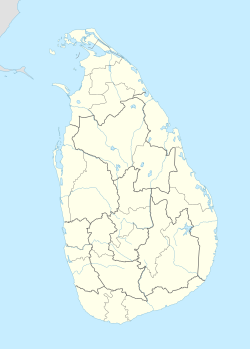Top Qs
Timeline
Chat
Perspective
Kuliyapitiya
Town in Sri Lanka From Wikipedia, the free encyclopedia
Remove ads
Kuliyapitiya is the second largest town in Kurunegala District, North Western Province, Sri Lanka, governed by an Urban Council. It is located 82 kilometres (51 mi) north-east of Colombo and 38 kilometres (24 mi) from Kurunegala. Kuliyapitiya is home to the Wayamba University of Sri Lanka. Coconut and paddy cultivation are the main economic activities in this area. The town centre includes commerce and retail enterprises.
This article has multiple issues. Please help improve it or discuss these issues on the talk page. (Learn how and when to remove these messages)
|
Remove ads
Transport
The Kuliyapitiya bus station provides transport to and from other locations in Sri Lanka: Colombo, Jaffna, Gampola, Anuradhapura, Nuwaragala, Katharagama, Kalpitiya, Panduwasnuwara to Colombo via Kuliyapitiya, Kuliyapitiya to Puttlam via Nikaweratiya. Other bus services go to Kurunegala, Negombo, Gampaha, Pannala, Giriulla, Chilaw, Hettipola, Madampe, Bingiriya, Nikaweratiya, Katupotha and Makandura.
There are no train stations near Kuliyapitiya.
Remove ads
Hospitals/Health
Kuliyapitiya Hospital is a teaching Hospital and in Kuliyapitiya Faculty of Medicine of Wayaba University.
Education
Wayamba University is the thirteenth national university in Sri Lanka and is located in Kuliyapitiya. It was established in January 1999. Its main purpose is to offer English degrees, diplomas and certificate courses (both internal and external) in areas such as agriculture, engineering and management.
Education is delivered free of charge to all students of national schools, according to the government policy. These schools operate under the Provincial Council. There are also a number of privately owned schools.
Schools in the area
- Central College Kuliyapitiya
- Saranath College Kuliyapitiya
- Holy Angels Girls College
- St. Joseph Boys College
- Assedduma Subharathi Vidyalaya
- Kanadulla Dharmaraja Adarsha Vidyalaya
- Vishakha Girls College
Sports
The two main sports grounds in Kuliyapitiya are the Shilpashalika Ground and the Urban Council Ground.
The Shilpashalika Ground was initiated by President Chandrika Kumaratunga.[when?]
Demographics
According to the 2012 census data, the estimated population of Kuliyapitiya was 77,316.[4] The male population was 36,670 and the female population was 40,646. Most of the Kuliyapitiya residents belong to the Sinhalese majority, other ethnic minorities include the Sri Lankan Moors, Sri Lankan Tamils, Burghers and Malays.
Following Table summarizes the population of Kuliyapitiya according to different ethnicities.
Remove ads
Climate
The climate in Kuliyapitiya is fairly temperate and tropical throughout the year. However, during April the temperature can rise to about 35 °C (95 °F). The only major change in the Kuliyapitiya weather occurs during the monsoons from May to August and October to January when heavy rains can be expected. In general, temperatures during late November to mid February period are lower than the rest of the year.
Remove ads
Heritage
The main heritage sites around Kuliyapitiya include the ancient Kabalewa (Buddhist) temple and dewala, Panduwasnuwara temple and ancient city, Angomuwa ancient Buddhist temple. The Kabalewa temple is situated at one end of Kuliyapitiya, whilst the Paduwasnuwara ancient city is near the Chilaw-Wariyapola road, close to Hettipola. The Dandagomuwa Ancient temple is near Kuliyapitiya.
References
Wikiwand - on
Seamless Wikipedia browsing. On steroids.
Remove ads
